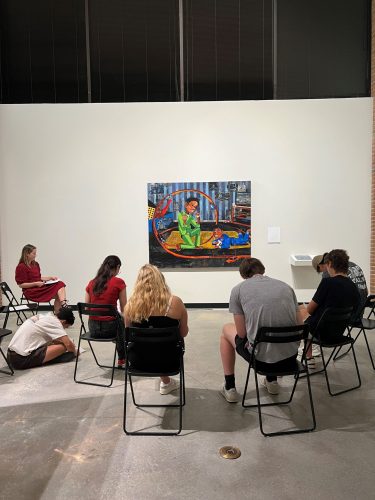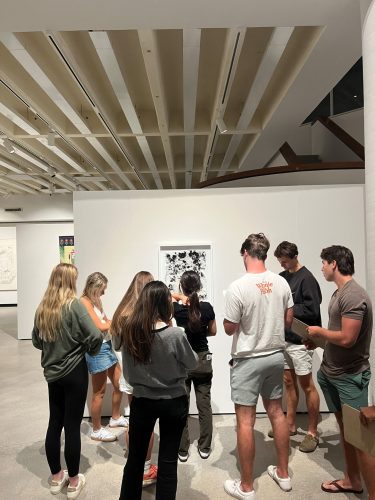Several years ago at a LOEX conference, I attended an engaging presentation on a partnership between a Librarian and an Art Gallery Curator at DePauw University that married Visual Thinking Strategies (VTS) and the Framework for Information Literacy. The result was an engaging and impactful addition to a seminar course for underclassmen and I had all of the best intentions to incorporate this into LIB 100 the following semester. Just like my intentions for this blog, it didn’t happen as immediately as I had hoped. Attending the CAT’s Teacher Scholar Forum recently with its emphasis on cultivating attention skills reminded me to share my exercise with VTS in LIB 100. Through this exercise, students practiced several of the skills and dispositions of information literacy, including valuing intellectual curiosity in developing questions and learning new investigative methods, maintaining an open mind and a critical stance, and valuing persistence, adaptability, and flexibility and recognize that ambiguity can benefit the research process, and intentionally placing students into a situation that would build intellectual humility (i.e., recognize their own intellectual or experiential limitations).
I was finally pushed to include VTS in LIB 100 after feeling intense pressure to incorporate more generative AI into my instruction. I debated all summer over what innovative, “next gen” coursework I should create for students and finally threw up my hands and admitted that a “luddite” approach is what I really wanted for my students and I. Paying close attention to something, searching for additional layers of meaning, and being in situations where we are out of our intellectual comfort zone are important for research and for life and so antithetical to the draw and premise of GAI tools like ChatGPT that deliver on demand and sacrifice accuracy for customer satisfaction.

I partnered with Hanes Gallery curator Dr. Jennifer Finkel to facilitate VTS in LIB 100, and she was instrumental in selecting two high-impact works of art that would be on exhibit at the time of the course. These works were newly acquired through The Mark H. Reece Collection of Student-Acquired Contemporary Art and one of the artists whose works we selected was scheduled to visit campus for a panel discussion.
Over the course, LIB 100 students visited the Hanes Art Gallery twice and were led through an activity that required them to view a single work of art and do nothing else for a total of ten minutes each session. It may not sound like a long time to pay attention, but we were all sweating by the end of the first five minute observation period. Between and after viewings, students were invited to share what they observed that made them draw a particular conclusion about what was going on in that work. They were also encouraged to incorporate evidence and ideas presented by a peer that made them rethink or revise their own initial theses. Finally, we heard from Dr. Finkel, who shared expert insights and contextual information about the works and the artistic traditions they were situated within. After both sessions, students were invited to attend a panel on the University’s Slavery, Race and Memory work to hear from another expert: Adebunmi Gbadebo, whose work we viewed. Students were required to use the works we viewed as a springboard for their research projects in the class and the creative topics that emerged were both interesting and challenging.
 Student feedback at the end of the course was overwhelmingly positive and indicative that even the most experienced of the LIB 100 student researchers was challenged by and benefited from our VTS/Framework approach to research over the term. One student explained:
Student feedback at the end of the course was overwhelmingly positive and indicative that even the most experienced of the LIB 100 student researchers was challenged by and benefited from our VTS/Framework approach to research over the term. One student explained:
As I learned more about finding different types of sources and evaluating them in new ways, though, I found the class visits to the Hanes Gallery and Special Collections particularly helpful. I was specifically able to learn about and practice new research skills that I had not engaged with before. This hands-on practice was particularly beneficial since, as I conduct more rigorous research in writing my senior thesis, I can find sources and information in new ways. As I finish my time at Wake and prepare for a career in politics interpreting and crafting policy, I know that the skills I learned in LIB 100 will help me find information and conduct research effectively.
I am so grateful to Dr. Finkel and the Hanes Gallery staff, my curious and engaged LIB 100 students, and ZSR colleagues who encourage pedagogical experimentation for making VTS in research instruction a reality. I look forward to taking more LIB 100 students to Hanes Gallery in the semesters to come!

6 Comments on ‘Teaching Research Creativity with Visual Thinking Strategies (VTS) in Hanes Gallery’
This is fantastic. I think this is a great idea and congratulations for pushing through to accomplish a meaningful ending.
“Paying close attention to something, searching for additional layers of meaning, and being in situations where we are out of our intellectual comfort zone are important for research and for life and so antithetical to the draw and premise of GAI tools like ChatGPT that deliver on demand and sacrifice accuracy for customer satisfaction.” Yep. A thousand times yes.
Very cool, Elizabeth!
As an undergraduate Studio Art and English major at WFU, I love seeing this use of art for info lit!
Incredible work, Elizabeth! Thanks for sharing.
Thanks for sharing a glimpse into your area of library work! I’m glad your pedagogical experimentation was such a success!